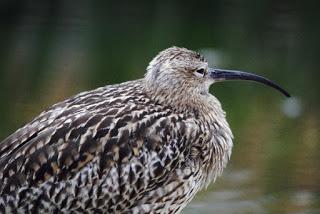
Curlew © Amy Lewis
We have lost almost half of our breeding Curlews during the last 20 years and a scientific paper, just published in the journal Bird Study, looks at the reasons why.The UK holds almost a third of the global breeding population of Curlew. Declines here have been greatest in Scotland, Wales and Northern Ireland, and in Ireland the breeding range has contracted by a massive 78%. As a result of this the Curlew has been proposed as the UK’s highest avian conservation priority. By analysing long-term monitoring data, collected by thousands of volunteer birdwatchers from across the country as part of the BTO/RSPB/JNCC Breeding Bird Survey (BBS), the British Trust for Ornithology (BTO) has, for the first time, documented how a range of different pressures may be responsible for this national decline.
Curlews breed at highest densities in areas of semi-natural grassland and on moorland, and are particularly associated with the uplands. The study, led by Dr Samantha Franks, found that Curlew declines have been greatest in landscapes where these habitats have been afforested, and where populations of generalist predators (crows and foxes) are high. Being ground-nesters, this probably reflects the vulnerability of Curlew nests and chicks to predation. They also seemed to have declined more in warmer, drier areas, potentially through impacts on their invertebrate food.
The results also provide important information for conservationists aiming to protect the species. Positive associations between Curlew densities and both measures of game management and the extent of nature reserves suggest that these areas, which may be most likely to be managed favourably for the species, are increasingly important for the continued maintenance of breeding Curlew.
Dr Samantha Franks (BTO), lead author of the study, said, “A range of potential causes of Curlew decline have been suggested, from agricultural intensification to climate change. Our results show that many have probably played their part, with afforestation and predation by generalist predators probably the most important.”
Dr James Pearce-Higgins, Director of Science at the BTO, and author on the paper, said, “Given current trends in the British countryside, where many things are going wrong for our breeding Curlew, it is difficult to be optimistic about how many of our children and grandchildren will continue to hear the evocative call of the Curlew echoing across the landscape. However, our results provide a glimmer of hope that effective site protection and measures to reduce predator impacts, along with management to improve breeding habitat across the countryside, may help maintain breeding populations into the future.”
Dr David Douglas, Principal Conservation Scientist at the RSPB and an author on the paper, said “This study provides further important evidence to help guide conservation efforts for breeding Curlew. Mitigating climatic effects may become increasingly important, and the results also suggest that providing suitable habitat and reducing predation pressure may be key for maintaining Curlew populations.”

